When people think about Japan, one of the first things they think of is Sumo Wrestling. So when people plan their trips to Japan, they often want to see a Sumo tournament. But what most people don’t realize is that getting to see a Sumo tournament or even a morning Sumo practice is normally quite difficult.
Nagoya is lucky to host the Summer Grand Sumo Tournament, one of only six tournaments each year. In addition to hosting the Sumo tournament, all of the 42 active Sumo stables will travel to Nagoya roughly two weeks before the tournament to train and acclimatize to Nagoya’s hot and humid summer weather. During this time, a large number of stables allow visitors to observe their morning training.
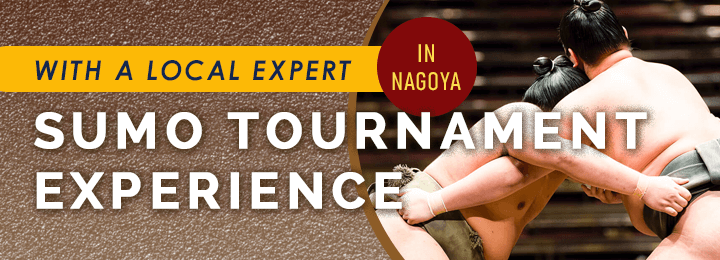
Article Contents
Where Did Sumo All Begin?
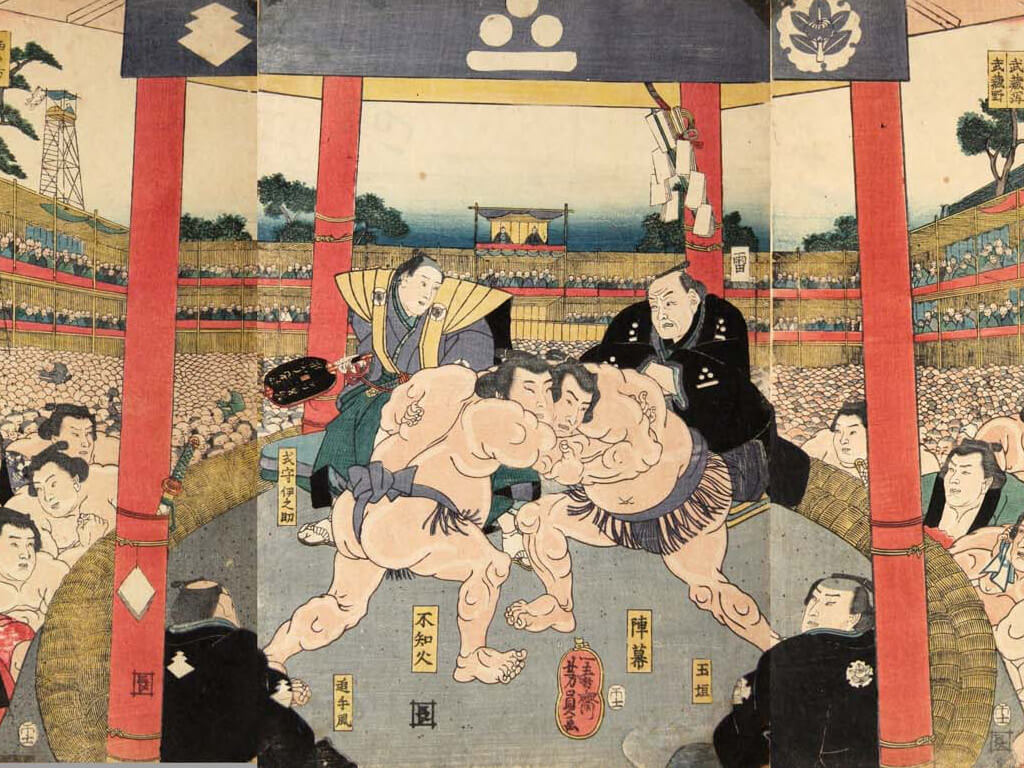
While professional Sumo didn’t begin until the Edo Period (1603-1868), Sumo originally started around 2,000 years ago as a Shinto ceremony to ensure a successful harvest. Its origins can be found in Japanese mythology, with Sumo appearing in two of the oldest historical texts of Japan: “Records of Ancient Matters” (Kojiki) and “The Chronicles of Japan” (Nihonshoki).
During the Heian Period (794-1185), the imperial court gathered powerful men from all over the country to perform Sumo as part of a religious ceremony, to pray for a good harvest, national peace, and prosperity. Over time this ceremony became a form of entertainment and was set as a regular event in the imperial court calendar.
At that time, the ring (Dohyo) had not yet been introduced and the rules were somewhat different. The objective of the match was to push or throw your opponent down or make him touch the ground with his hand or knee.
In the year 833, during the reign of Emperor Kinmei, Sumo was declared as something more than a kind of courtly entertainment, and it became part of military education and training for men.
With the rise of the Samurai class during the Kamakura Period (1185-1333), Sumo became a part of Samurai training. Sumo tournaments were often held for the Shogun’s amusement and also as a method to raise funds for temples and shrines. Samurai began to gather from all parts of the country to compete. Around this time, a referee (Gyoji) would start having a crucial role in the tournaments.
During the Edo Period (1603-1868) Sumo tournaments began to take place throughout the country with or without Samurai. Men of great physical prowess began to train and treated Sumo as a profession. In Edo (the old name of Tokyo), Sumo tournaments often became places of violent fights between spectators, to the point where the government temporarily had to ban Sumo.
In 1684 the government began to allow Sumo matches for specific purposes such as charity events for shrines and temples. It was during this period that Sumo truly began to take on its current shape. The first sanctioned tournament took place at this time and the first Sumo superstars began to emerge. The popularity of Sumo as a form of mass entertainment continued to increase and special performances were held for the Shogun at Edo Castle. This was the beginning of the first Golden Age of Sumo. At one large tournament with over 1,000 wrestlers and multiple matches at the same time, circles were drawn on the ground to help keep matches separate, and thus the Dohyo or Sumo ring was born.
Sumo Tournament – Basics Explained
Every year Nagoya hosts the Summer Grand Sumo Tournament (Nagoya Basho). In 2023 it is held from July 9th to 23rd.
It is one of the six major Sumo tournaments held in Japan. This Grand Sumo Tournament is held in July at the Dolphins Arena (Aichi Prefectural Gymnasium), next to Nagoya Castle. Each tournament (Basho) lasts 15 consecutive days, during which the wrestlers compete to win the Basho, which is determined by the best win/loss record over the 15 days.
The Ring (Dohyo)
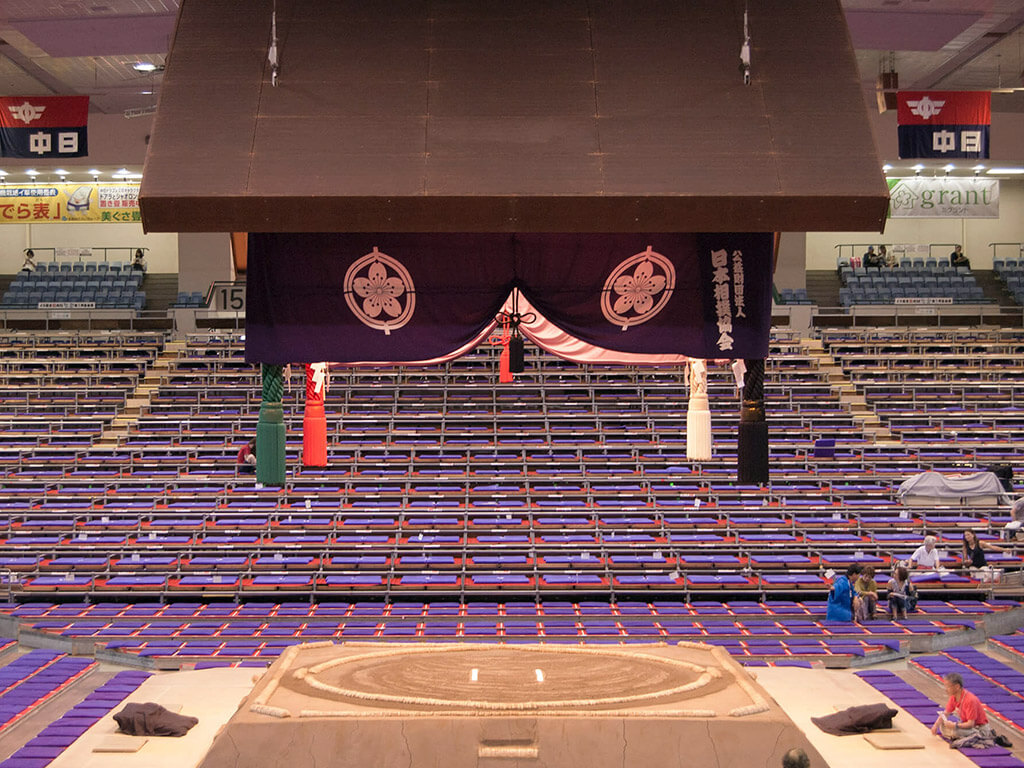
Sumo wrestlers are called Rikishi in Japanese, and fight in a ring called Dohyo. The Dohyo is built by hand by the Yobidashi or Beckoners, master craftsmen, to very precise specifications for each tournament. Each time it takes about a week to build. The circle and its edges are made of bales of rice straw that are buried in the clay. Once the ring is built, a ring purification ceremony called Dohyo Matsuri is performed the day before the tournament begins. This ceremony is free and open to the public (in 2023 this ceremony is held on the 8th of July).
It not only purifies the ring but at the same time invites the Shinto deities (Kami) to come and watch the Sumo tournaments. The ceremony is led by one of the Tategyoji (main referees) along with two other Gyoji (assistant referees).
The Tategyoji will pray for the safety and well-being of the fighters. In the middle of the Dohyo 6 elements are buried: torreya nuts, dried chestnuts, salt, washed rice, dried squid, and Kombu (seaweed). Next, the Tategyoji will pour sacred Sake into the hole, as well as in several other places around the Dohyo before he puts more clay in the hole.
Finally, a Rikishi (wrestler) is called to the Dohyo by the Yobidashi, an announcer at a Sumo tournament, who will then cover the hole. The sacred Sake is shared with all the attendees.
To conclude the ceremony, the Yobidashi will lead a procession with Japanese Taiko drums around the Dohyo for three laps before officially announcing the beginning of the tournament.
A roof resembling a Shinto shrine called a Tsuriyane is suspended above the Dohyo. This roof weighs 6.25 tons and is supported by cables that can hold up to 30 tons. Around the Tsuriyane hangs a purple banner which is embroidered with the Japan Sumo Association’s symbol called a Mon. Originally the roof had been supported by columns, but they were removed to allow fans an uninterrupted view of the Dohyo. Colored tassels, which replaced the colored columns, are suspended from the corners. They represent the four seasons and the four spirits of directions:
Green – Azure Dragon of the East represents Spring
Red – Vermilion Bird of the South represents Summer
White – White Tiger of the West represents Fall
Black – Black Tortoise of the North represents Winter
An important note about the Dohyo is that, according to the rules of Sumo, it is strictly forbidden for a woman to set foot in the sacred ring.
A curious fact about the Dohyo is that on the last day of the Grand Sumo Tournament in Nagoya, fans break a piece of clay from the ring to take as a souvenir.
Sumo Rules and How to Win!
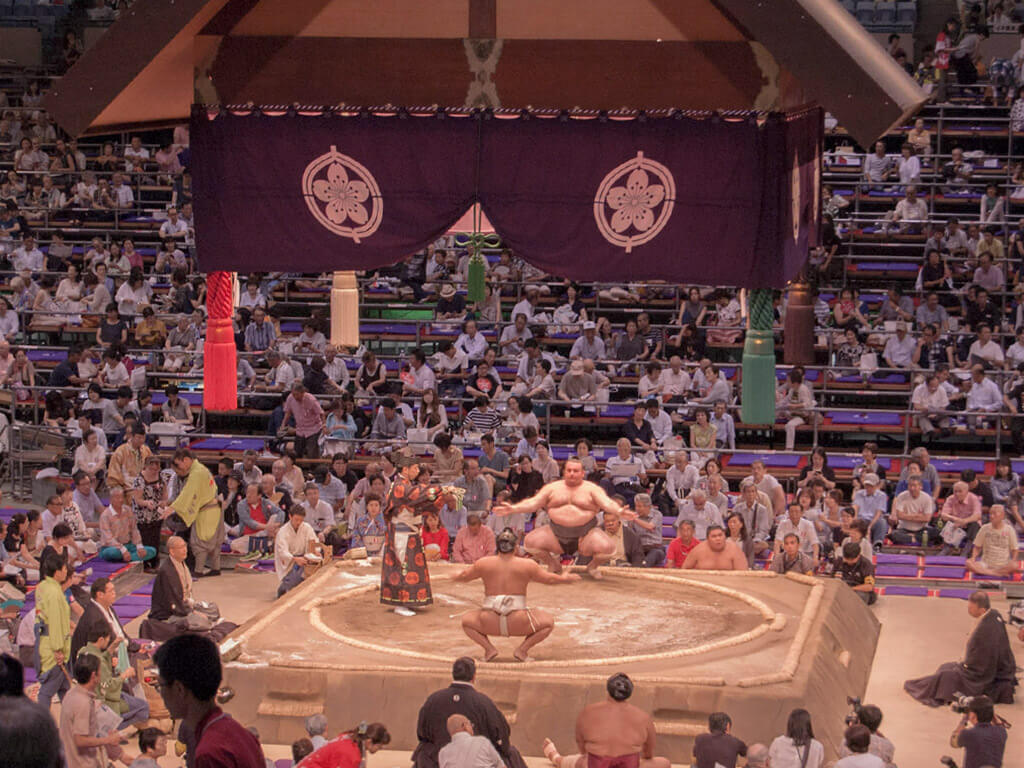
The rules are simple: the fighter who first leaves the ring or touches the ground with any part of his body besides the soles of his feet loses. The tournaments take place in a raised ring, which is made of clay and covered with a layer of sand.
While most matches usually last only a few seconds, some matches can take a minute or more. While very uncommon it is even possible for a match to end in a draw. But as the last time this happened was in 1974 you are not likely to see a draw when you visit.
There are no restrictions on weight or height, which means that some matches can have two very different-sized wrestlers. But the weight alone does not decide the outcome of a match, qualities such as agility and speed or good strategy are much more important.
Sumo Stables are divided into two groupings, East and West. The Rikishi are placed in the Dohyo according to whether they are from the East or the West. The Rikishi from the east group always enters first. They enter the Dohyo and perform a special ritual. The ritual begins with the Rikishi clapping their hands to attract the attention of the gods, and then raising their arms to the sky to show that they do not carry weapons. Finally, they raise their legs and trample the ground multiple times to crush and chase away any persistent evil spirits.
Officially there are 82 techniques called Kimarite through which a Rikishi can win their bout. But only about a dozen are used regularly. Sometimes a fight can end in a disqualification if one of the fighters commits a foul (Kinjite), such as hitting with a clenched fist or pulling their opponent’s hair.
Sumo Techniques
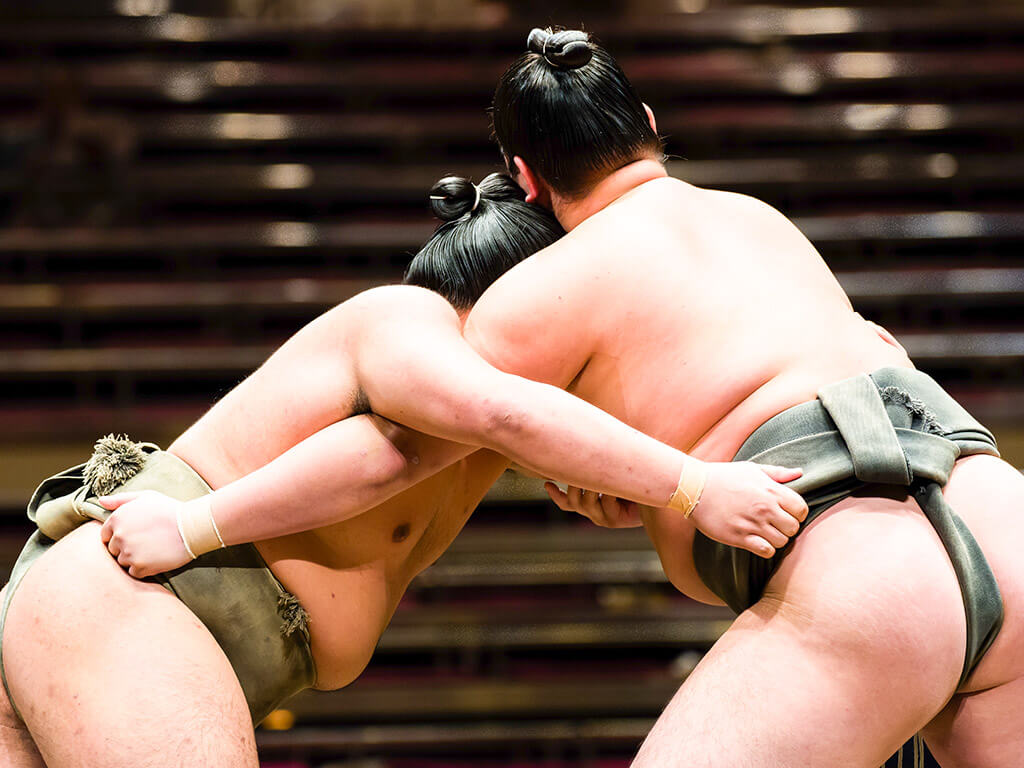
As we mentioned in the last section, there are about 82 match-winning techniques and 5 ways to be disqualified, as defined by the Japan Sumo Association.
The common strategies are the Yori-kiri and the Oshi-dashi. The Yori-kiri is executed when a Rikishi is facing his opponent and pushes him out of the Dohyo while holding his opponent’s Mawashi (the belt worn by all Sumo wrestlers). Oshi-dashi is when a Rikishi pushes his opponent out of the ring with one or both hands on the opponent’s body.
Sumo Divisions
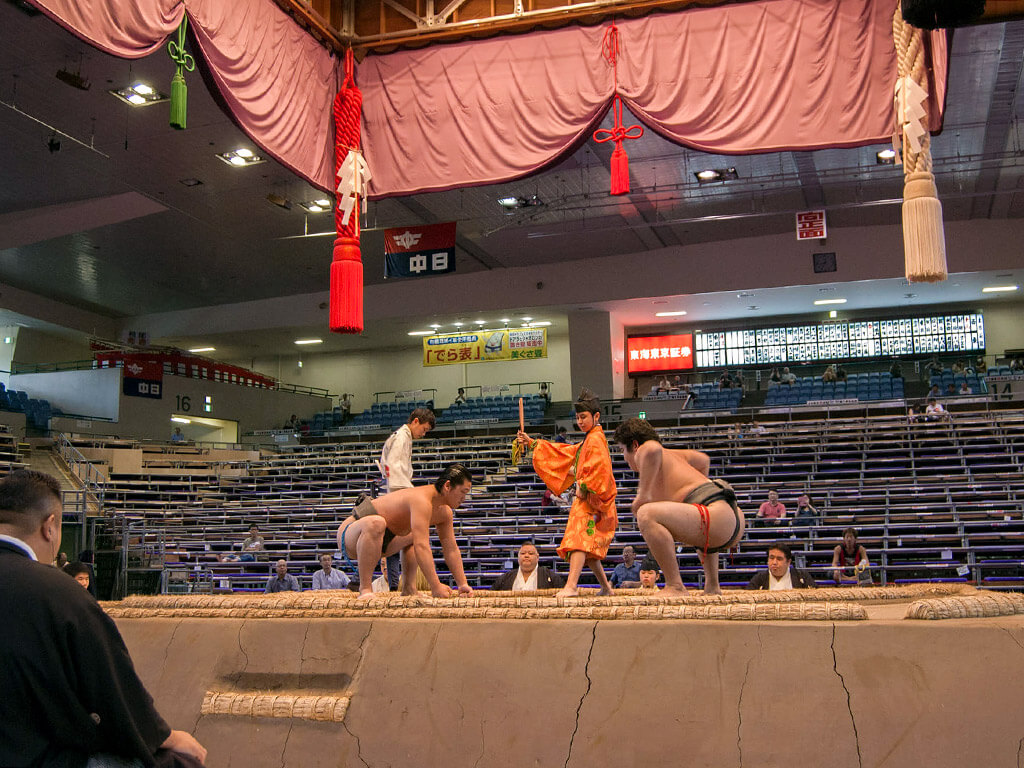
Professional Sumo is divided into six divisions. Wrestlers are promoted and /or demoted within and between these divisions based on their win/loss records, called Kachi-koshi / Make-koshi in Japanese, in official tournaments. Makuuchi, Juryo, Makushita, Sandanme, Jonidan, and Jonokuchi, are the six divisions but there are also further sub-rankings within these divisions. The higher a fighter’s rank within a division, the stronger the general level of opponents he will face. In turn, each rank is subdivided into East and West.
Makuuchi is the top division, within this, the rankings are Yokozuna, Ozeki, Sekiwake, Komusubi, and Maegashira.
The next division is the Juryo. Below the Juryo division comes the Makushita.
Wrestlers in the Makushita division and below are considered to be still in training. Next are the Sandanme, Jonidan, and Jonokuchi who are the lowest-ranked and have only just begun in the sport.
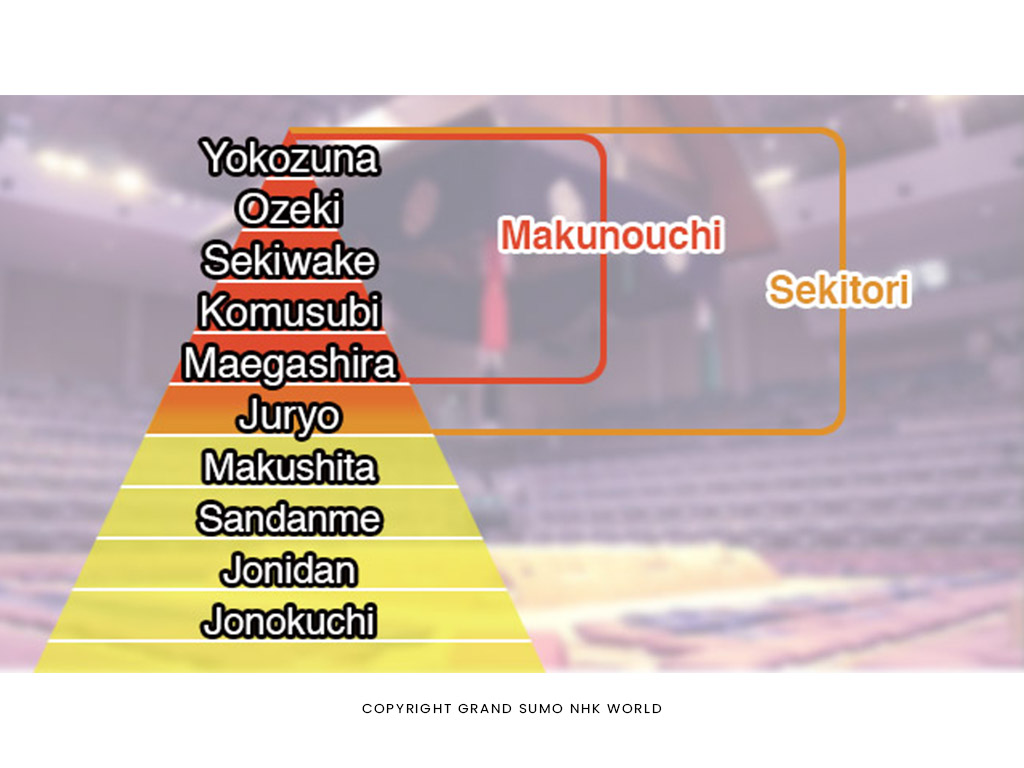
Sumo Wrestlers
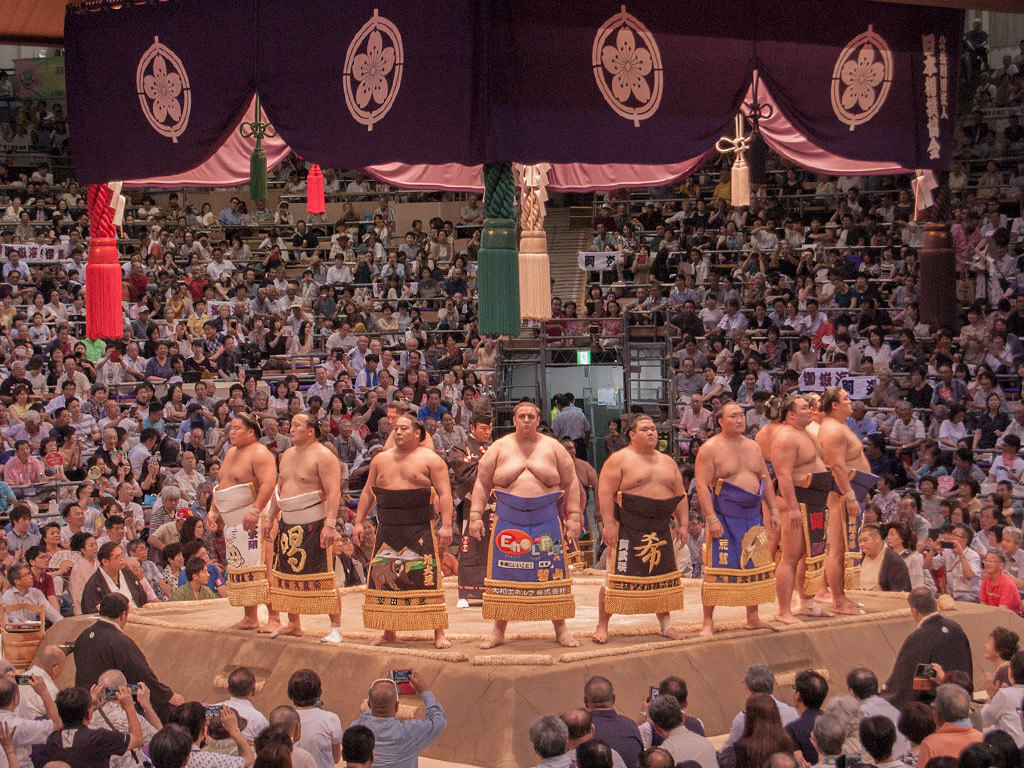
Rikishi, the Japanese word for Sumo wrestler means “man of strength”.
Click here if you want to see a current list of all Sumo wrestlers in Japan.
How a Typical Tournament Day Progresses
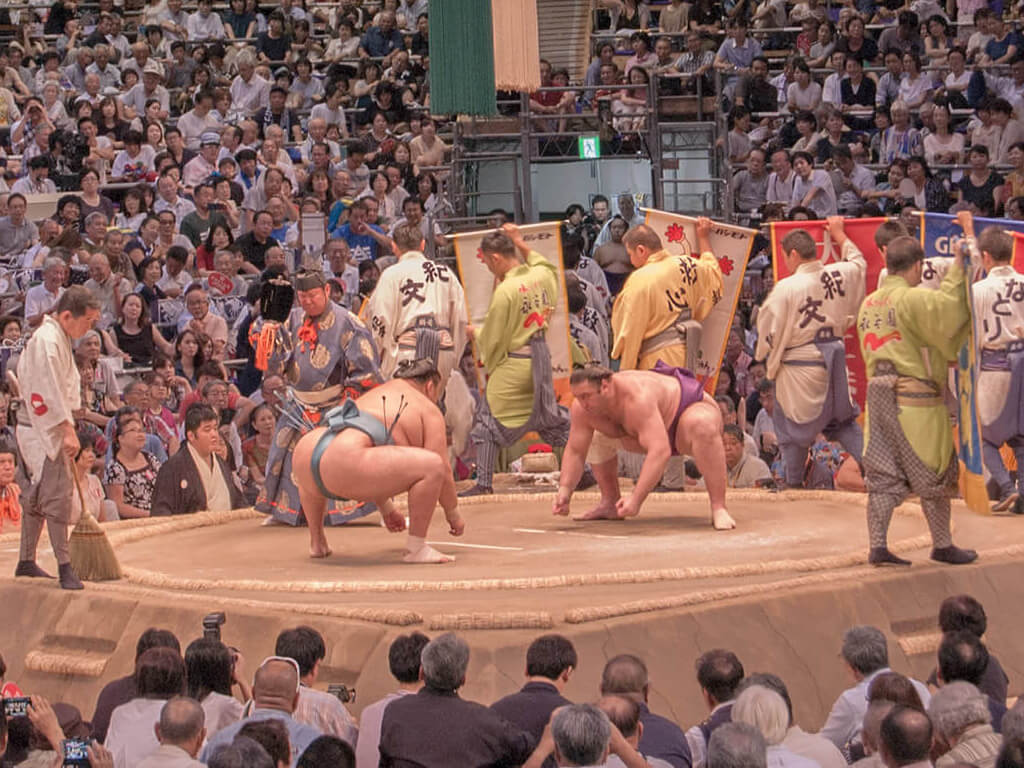
Sumo is an event that lasts all day. The tournaments are conducted in order, progressing from the lowest divisions in the morning to the upper divisions in the afternoon.
All six Sumo tournaments across Japan follow the same pattern. The earliest matches of the day are between the lowest-ranked wrestlers. Their matches begin at 8:30. Juryo (second division) matches begin at 15:00 while Makuuchi (top division) matches begin at 16:00. The highest-ranked wrestlers have their matches just before 18:00. The time schedule is the same throughout the entire 15 days of a tournament with the exception of the last day when the schedule is shifted forward by 30 minutes to allow time for the victory ceremony.
While it is possible to buy tickets and attend a Sumo tournament for the entire day, we would recommend making sure to catch the afternoon bouts and not worrying too much about the lower-division matches. The main action usually takes place between 15:30 and 18:00.
Before each division begins its matches for the day, a very interesting ring-entering ceremony is performed. A special procession called Dohyo-iri where the Rikishi stand outside the circle of the Dohyo wearing their Mawashi (silk loincloth) and perform a kind of ritual: they clap and rub their hands to make sure that the gods are watching, and also to symbolize the cleansing process. Before leaving the ring, they make a movement with their Mawashi to show that they do not have any hidden weapons.
Before each bout, there is a ritual consisting of salt throwing, leg stretching, squatting, and stamping that can continue for 4-5 minutes before the match must begin. The salt thrown before the start of a bout is done to both purify the Dohyo as well as protect the wrestler from injury. When the referee indicates that it is time for the match to begin, both Rikishi will put one fist on the ground. When both wrestlers have touched their second fists on the ground, the match begins. Sometimes this can happen in a split second. Watching the wrestlers’ bodies collide with each other is an impressive sight to watch live.
The judges are the Oyakata (stable master) wearing a black Kimono and are positioned on each side of the Dohyo. Depending on the bout, if there is any question about a referee’s call, they will enter the ring and confer to make the final decision. Once made, they announce and explain their decision.
The referees are distinctive in their colorful costumes and stand in the Dohyo during the bout. After introducing the contestants the referee watches the match carefully and calls out words of encouragement.

You will probably be wondering what those banners that are displayed are. The banners you see paraded around the Dohyo prior to higher-ranking bouts are advertising for the sponsors of the match who have provided prize money.
When a bout ends the winning Rikishi receives a pack of envelopes. These envelopes are called Kensho and contain money from sponsors of the match. This money supplements any official prize money the winners or recipients of special prizes receive.
Each day of the tournament ends with a Yumitori-shiki or bow-twirling ceremony. This is usually done by a wrestler from the Makuuchi (top division). Originally a bow was one of the prizes for winning a Sumo tournament. At that time the ceremony was performed by the winner of the tournament. But after the bow was removed from the prizes awarded to the winner, the bow-twirling ceremony was kept and performed by different wrestlers at the end of the day.
The ceremony has very specific movements, each with its own meaning. The bow is first twirled around the head which is believed to drive away any evil spirits floating in the air. Then the bow is used as if the Rikishi was trying to dig up the ground. This symbolizes the cleansing of the soil. Finally, the Rikishi will stomp on the ground to crush any remaining evil spirits. The purification ceremony helps prepare for the next day’s matches.
No Sumo Tournament Is Complete without Food and Drink
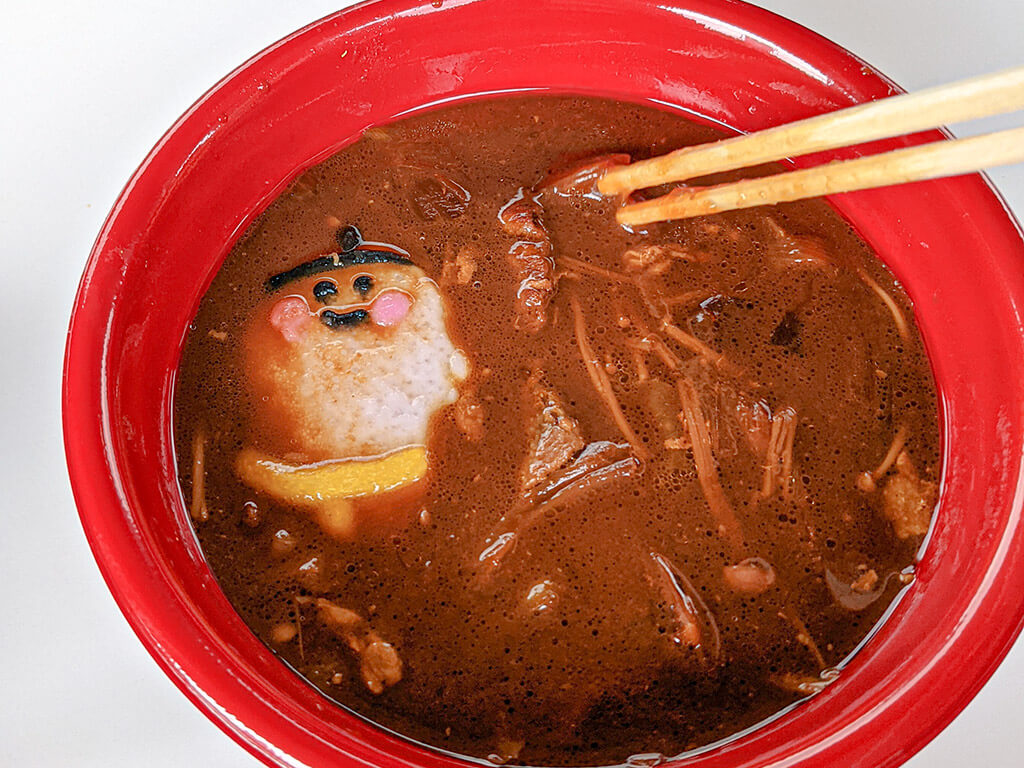
Much like a baseball game, snacks and drinks (including alcohol) are allowed to be consumed throughout the day. On each floor of the stadium, there are small food stalls where you can find Sushi, Yakitori, Yakisoba, and more. Or you can also choose to reserve a special Bento lunch box to enjoy the event even more. There are also several vendors who walk around the stadium selling snacks, drinks, and ice cream.
Tips to Enjoy the Sumo Tournament
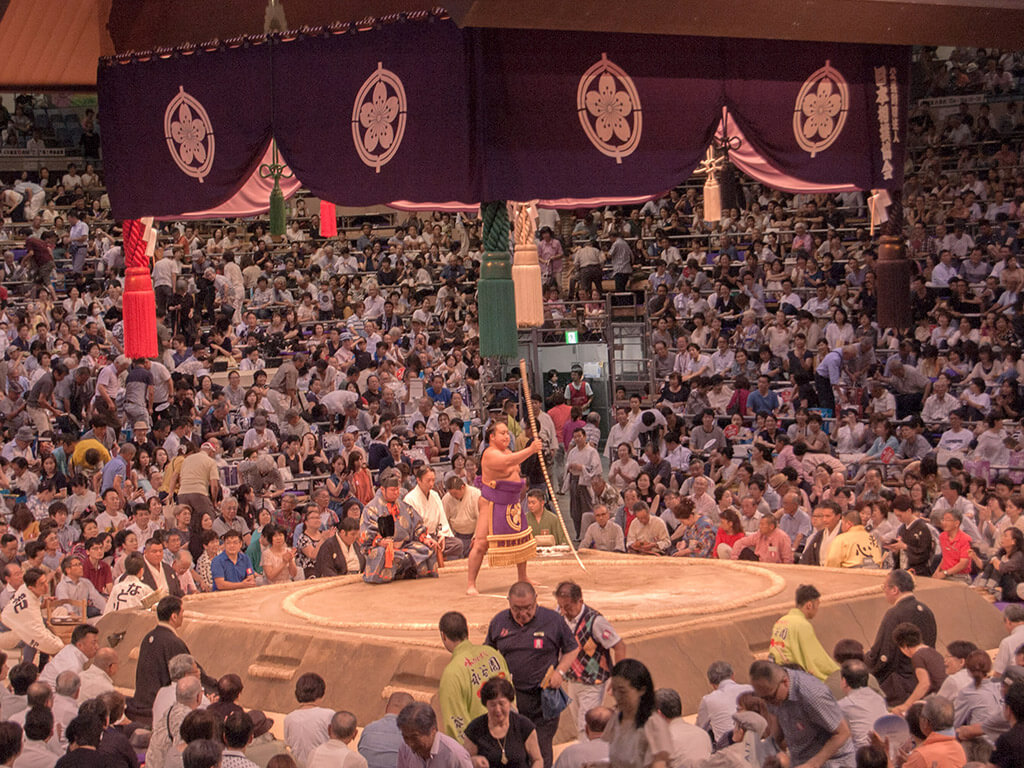
1. If you are in Nagoya and don’t want to miss the opportunity to attend a tournament day you can book your tickets in advance online beginning roughly a month in advance. Tickets for the last days of the tournament usually sell out within an hour of going on sale so advance booking of tickets is not easy.
2. Another option is to line up in the early morning before the ticket office opens at 7:30 on the day of the tournament to purchase an unreserved seat.
3. The best way to experience Sumo is with a knowledgeable guide. You can book a private experience with our guide, Elly, here for the Summer Grand Sumo Tournament here.
4. Since most of the small food and gift establishments inside the stadium do not accept credit cards, we recommend that you always carry cash with you.
How to Get to the Nagoya Sumo Tournament Venue
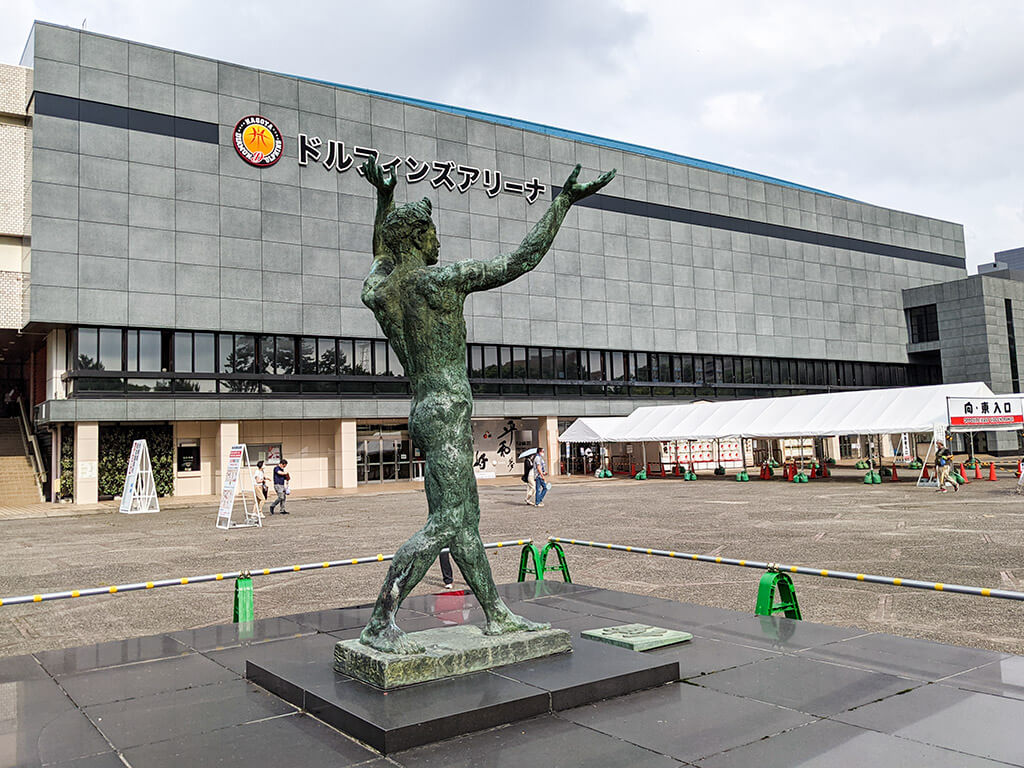
The Dolphins Arena is located next to Nagoya Castle. You can take the Meijo subway line to Nagoyajo Station. From Exit 7 it is a 5-minute walk to the venue.
Dolphins Arena (Aichi Prefectural Gymnasium)
Entry Fee: Varies depending on the seat.
Date: 9th to 23rd (Sun-Sun) of July 2023
Opening Hours: 8:30 – 18:00, from the 13th to the 15th day of the tournament 10:00 – 18:00
Address: 1-1 Ninomaru, Naka Ward, Nagoya, Aichi 460-0032
Access: Take the Meijo subway line to Nagoyajo station. From there it is a 5-minute walk from exit 7.
Website (Japanese only) | Google Maps
The second part of this article about Sumo can be found here.

Did you enjoy this article?
Make sure to also check out our other posts about Nagoya and trust us if we say Nagoya is not boring!
Be sure to follow us on Facebook for regular updates on Nagoya, and see our Instagram for pictures and stories about the city!
Tag us 📲
If you have visited the Summer Grand Sumo Tournament in Nagoya, please share your experience and tag us on social media with #nagoyaisnotboring

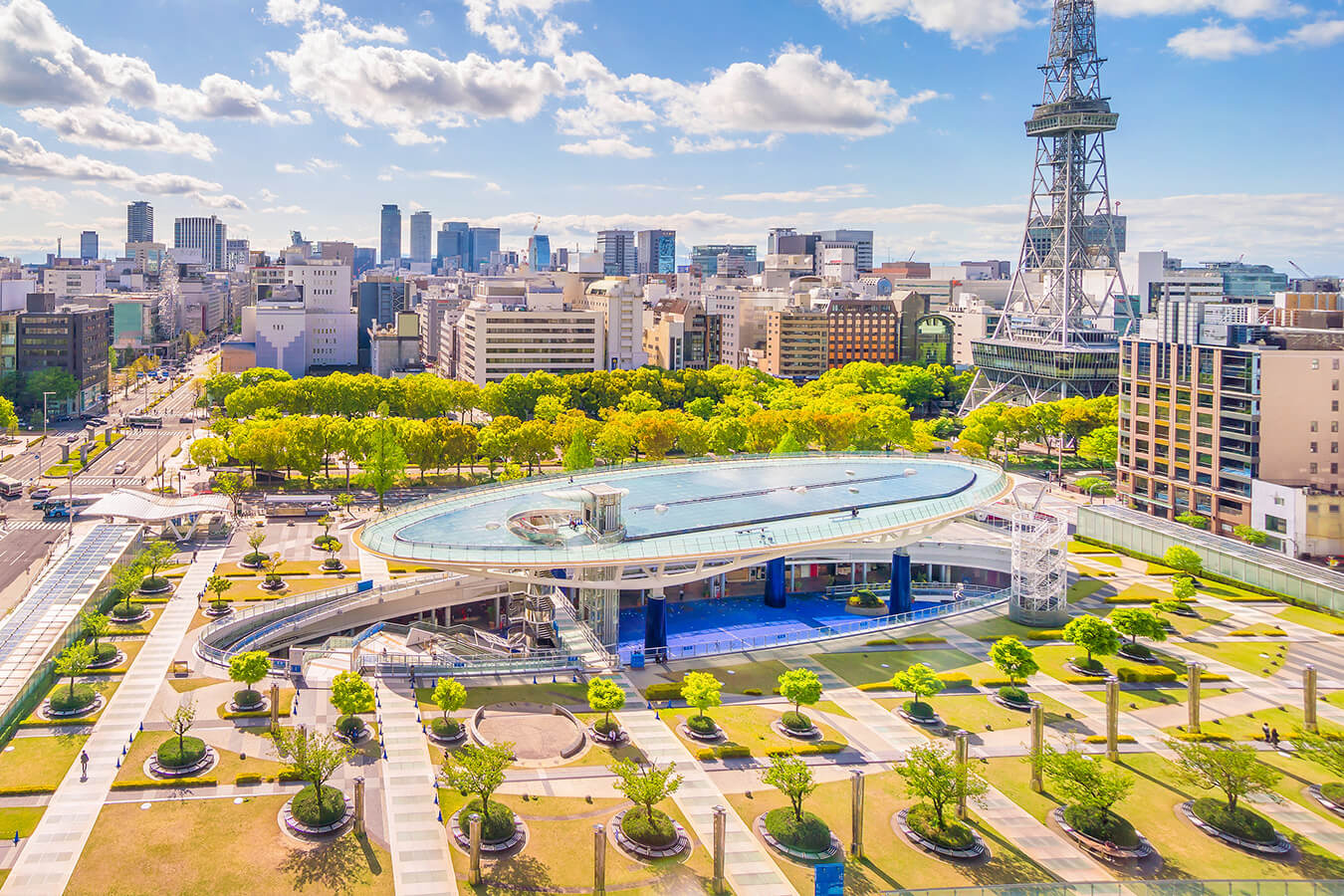
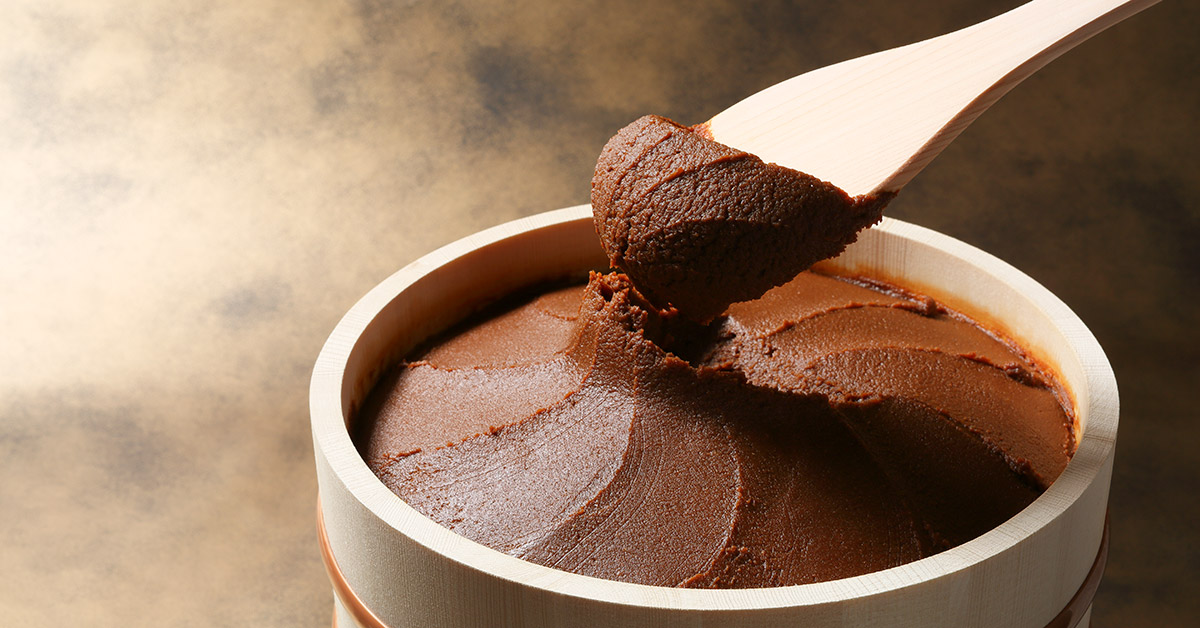
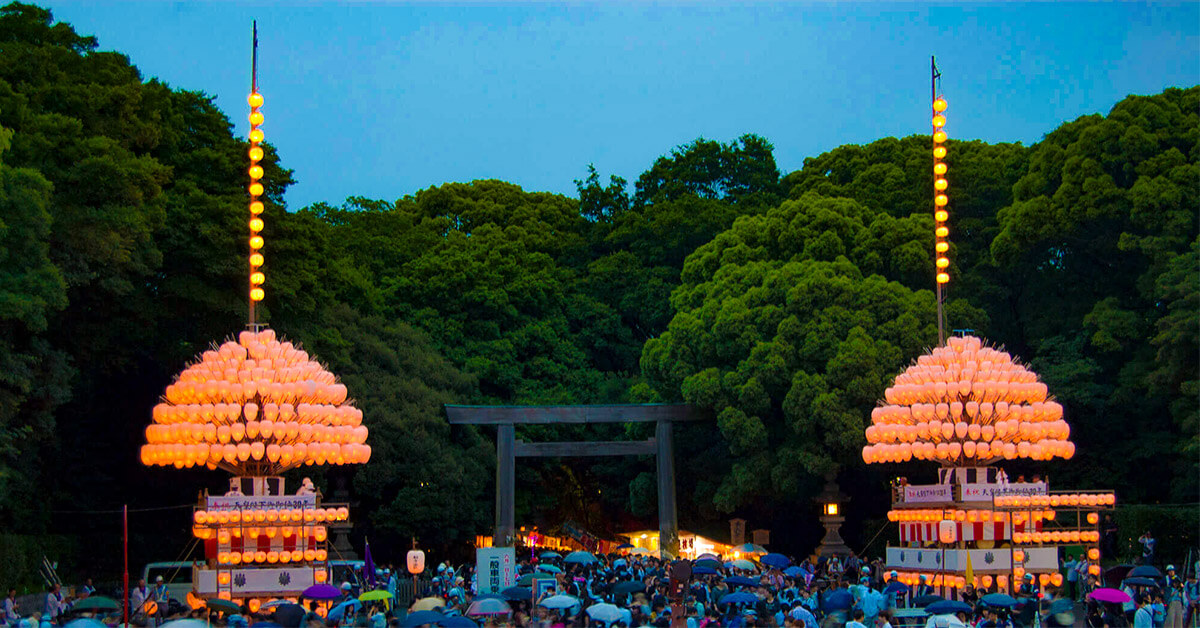
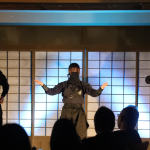
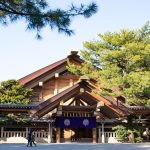
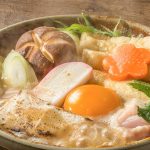

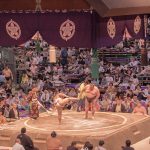

Great article Elisabeth.
I have tickets for this Thursday 13th sumo tournament in Nagoya. Very excited and really looking forward to it. Did you like the Netflix SANCTUARY series?
Dear Pete, thanks for your comment. Hope you enjoy Nagoya Grand Sumo Tournament! ^^
And yes, I watched the first season of the Netflix series, Sanctuary. I loved it. I’m very much looking forward to the second season. Kind regards, Elly